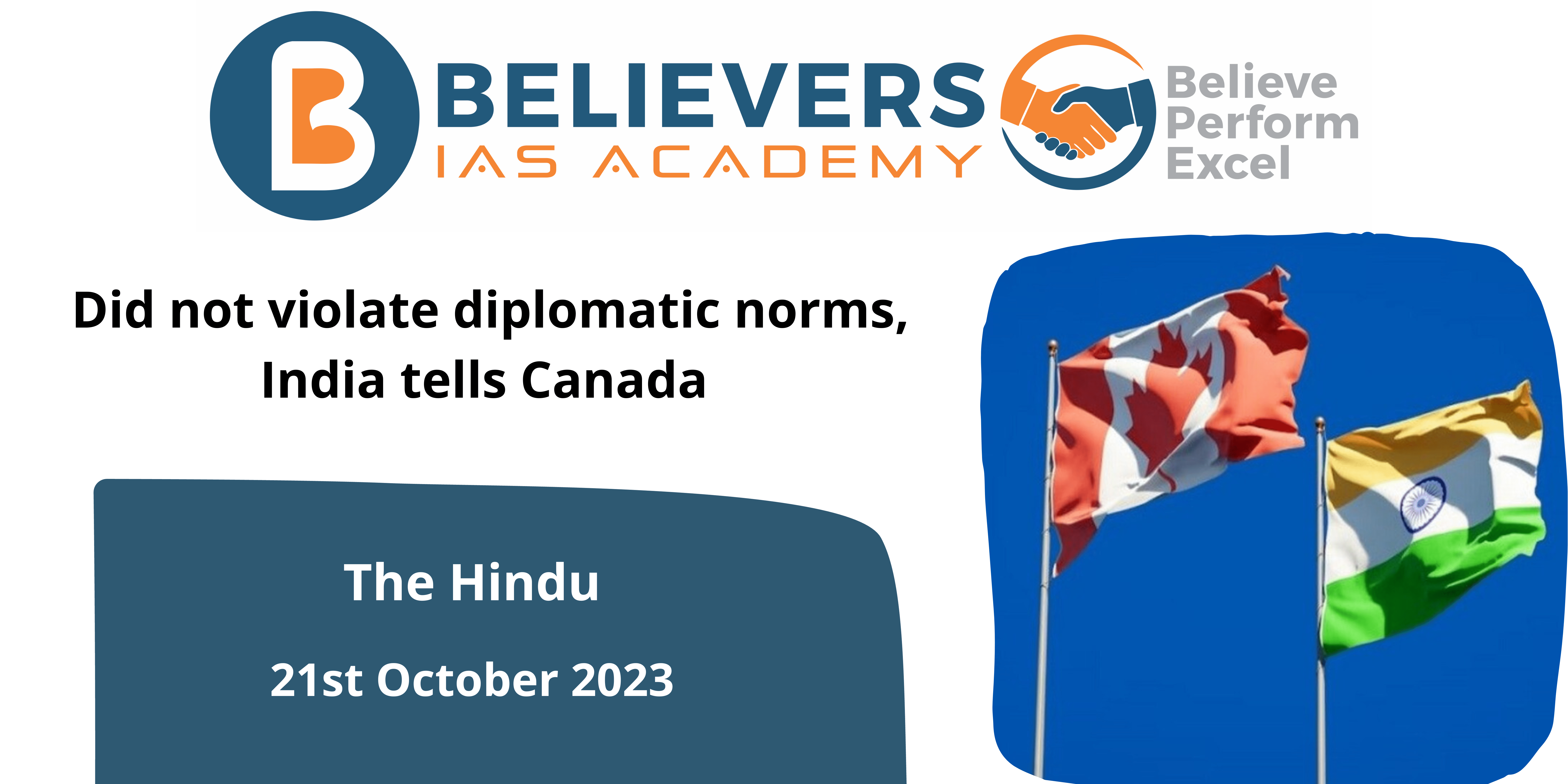Did not violate diplomatic norms, India tells Canada
Context
In response to Canadian Foreign Minister Melanie Joly, who accused India of breaking diplomatic protocol by requesting a reduction in the number of Canadian diplomats posted in India, the Ministry of External Affairs declared on Friday that India had not violated the Vienna Convention on Diplomatic Relations by asking for the return of 41 Canadian diplomats.
What is the historical background behind the Khalistani separatist movement?
- The Khalistan issue is a Sikh separatist movement that seeks to establish an independent state in the Punjab region called Khalistan.
- Its roots can be seen in India’s independence and subsequent Partition, which resulted in communal violence and the relocation of millions of people, including Sikhs.
- The Punjabi Suba Movement and the Anandpur Sahib Resolution, which requested greater autonomy for Punjab, fueled the movement.
- Under the leadership of Jarnail Singh Bhindranwale, who took up residence in the Golden Temple and founded the Dharam Yudh Morcha, the movement grew violent in the 1980s.
- In 1984, the Indian government began “Operation Blue Star” to clear out terrorists from the Golden Temple and bring Bhindranwale to justice. The raid caused significant damage to the Golden Temple and resulted in the deaths of several terrorists and bystanders.
- Following Operation Blue Star, there was communal violence and a long-running insurgency in Punjab that lasted until 1995.
- The movement failed to achieve its goal for a variety of reasons, including harsh police crackdowns, factional infighting, and Sikh disillusionment.
- Today, the movement is fuelled by vote bank politics, socioeconomic issues including unemployment and drug misuse in Punjab, and non-state actors’ backing.
- The movement continues to elicit sympathy and support from segments of the Sikh people, particularly the Sikh diaspora.
What are the recent events that triggered a reaction in the Indo-Candian relation?
- The leader of the Khalistan Tiger Force, Hardeep Singh Nijjar, was assassinated by unidentified gunmen in Surrey, Canada, in June.
- Justin Trudeau, the prime minister of Canada, claimed that the Indian government was responsible for the murder since it was an “unacceptable violation.”
- India rejected these allegations, stating that they were unsubstantiated and aimed at diverting attention from the activities of Khalistani operatives in Canada. India expressed concerns about the use of Canadian soil by “anti-India elements” and called for effective legal action against them.
What is the Vienna Convention of 1961?
- An international agreement known as the Vienna Convention on Diplomatic Relations provides a framework for diplomatic relations between nations. The United Nations Conference on Diplomatic Relations and Immunities in Vienna, Austria, adopted the treaty in 1961. By creating a unified set of norms and values, the treaty seeks to foster cordial ties between countries.
- The treaty outlines the guidelines for diplomatic relations between nations, comprising:
- The privileges that diplomats enjoy in other countries
- The three classes of heads of mission
- The members of the mission, including the head of the mission and the members of the staff
- Sixty-one nations signed the treaty in 1961. As of right now, 193 nations have signed the agreement.
What is India’s Stance on the accusation of breaking the Vienna Convention?
- Parity and the Vienna Convention: India argues that Article 11.1 of the Vienna Convention on Diplomatic Relations is in line with its request for the return of forty-one Canadian diplomats. India claims that this article supports its activities by allowing modifications to the number of ambassadors to ensure equity between countries.
- Charge of Excessive Diplomat Count: India claims that Canada has kept an excessively high number of diplomats in India, which has led India to request a reduction.
- involvement in Domestic Affairs: The reduction in diplomatic staff is attributed to Canada’s alleged “continuous interference” in India’s domestic affairs.
- Consultations: India reports that it has been in communication with Canada for around a month to iron out the specifics and procedures surrounding the reduction. After consulting the Canadian side, the deadline for compliance was extended.
What is Canada’s Stance on the issue?
- Conflict with International Law: Melanie Joly, Canada’s foreign minister, claims that India has violated international law, particularly the Vienna Convention on Diplomatic Relations, by unilaterally revoking diplomatic privileges and immunities from its diplomats.
- Unreasonable and Escalatory: Joly describes India’s moves as escalatory and unjustified, implying that Canada had granted accreditation to each of the diplomats who are currently being removed.
- Closure of Consulates: In reaction to the reduction in diplomatic personnel, the consulates of Canada in Bengaluru, Mumbai, and Chandigarh have been closed. Consular services in person will now only be offered at the Delhi High Commission.
- Effect on Services: According to Joly, Indian citizens’ access to and quality of some services will be impacted by the closing of consulates. Applications from India will still be accepted in Canada, but some prerequisites must be met locally or on-site.
What is the way forward from this situation?
- Diplomatic Dialogue: The first and most crucial step is for both India and Canada to engage in diplomatic dialogue to discuss the issues at hand. This should be done through diplomatic channels, with representatives from both countries working to understand each other’s concerns and objectives.
- Mediation: If direct bilateral discussions do not yield progress, both parties could consider involving a neutral third party or mediator to help facilitate the negotiation process. International organizations, such as the United Nations or regional organizations like the Commonwealth or the Organization of American States, can offer assistance in resolving diplomatic disputes.
- Legal Evaluation: To ascertain if any activities performed by either side are in breach of the Vienna Convention on Diplomatic Relations or other international laws, both countries may consult international law experts or other international bodies for legal advice and evaluations. This might offer a neutral starting point for conversations.
- Bilateral Agreements: To achieve mutual satisfaction and adherence to international law, India and Canada may look into the possibilities of negotiating bilateral agreements or understandings on the number of diplomats and diplomatic privileges.
- Reducing limits: Both nations may think about temporarily reducing the measures or limits put in place as a result of the dispute, such as closing consulates or removing diplomatic immunity. This may foster a conversational environment.
Conclusion
To summarize, India is arguing in this diplomatic issue that Canada should have the same number of diplomats as India, invoking the Vienna Convention on Diplomatic Relations. However, Canada believes that India’s activities are against international law and disagrees with them. Although the closing of Canadian consulates in India was a reaction to the reduction in diplomatic staff, an Indian source claims that India’s actions concerning diplomatic parity may not have had a direct influence on this decision. Interpreting the Vienna Convention is essential to the resolution of such conflicts, which usually entail diplomatic discussions and legal considerations.




